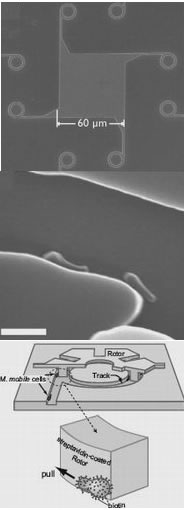Better Living Through Bacteria
Posted: Sat Mar 10, 2007 5:03 pm
Artificial DNA with encoded information can be added to the genome of common bacteria, thus preserving the data. The technique was developed at Keio University Institute for Advanced Biosciences and Keio University Shonan Fujisawa Campus. If you think those USB flash memory "thumbdrives" are small, check this data storage out.
According to researchers, up to 100 bits of data can be attached to each organism. Scientists successfully encoded and attached the phrase "e=mc2 1905" to the DNA of bacillus subtilis, a common soil bacteria.
One early use for the technique would be to create special markers to identify legitimate versions of pharmaceuticals. However, the bacillus itself creates new copies of the data every time it reproduces itself, thus making it an ideal archival storage system.
Bacillus subtilis also creates extra copies of the data, inserting it in different places in its genome, further safeguarding the data. That's "multiple backup copies" for those of you who have lost data in the past.
See here.
And also see here where we put the little buggers to work:
The bacteria-driven motor consists of a square central basin into which the M. mobile are deposited. As they move throughout the square, they eventually reach a side and move along it until approaching an entrance to one of four circular tracks. The entrance ways ensure that a majority of bacteria glide in the same direction around the tracks, which are each fitted with rotors that have protrusions in the track to allow the bacteria to bind to and pull the rotors.

And here where a new "language" was induced in bacteria.
A group of scientists lead by Professor James C. Liao are engineering an artificial cell-to-cell communication network by teaching bacteria to communicate with each other and to work together in a whole new way. Bacteria commonly use chemicals to signal each other; the researchers sought to get bacteria to use different chemicals. The intent of the research is to achieve "novel, nonnative behavior in bacteria."
According to researchers, up to 100 bits of data can be attached to each organism. Scientists successfully encoded and attached the phrase "e=mc2 1905" to the DNA of bacillus subtilis, a common soil bacteria.
One early use for the technique would be to create special markers to identify legitimate versions of pharmaceuticals. However, the bacillus itself creates new copies of the data every time it reproduces itself, thus making it an ideal archival storage system.
Bacillus subtilis also creates extra copies of the data, inserting it in different places in its genome, further safeguarding the data. That's "multiple backup copies" for those of you who have lost data in the past.
See here.
And also see here where we put the little buggers to work:
The bacteria-driven motor consists of a square central basin into which the M. mobile are deposited. As they move throughout the square, they eventually reach a side and move along it until approaching an entrance to one of four circular tracks. The entrance ways ensure that a majority of bacteria glide in the same direction around the tracks, which are each fitted with rotors that have protrusions in the track to allow the bacteria to bind to and pull the rotors.

And here where a new "language" was induced in bacteria.
A group of scientists lead by Professor James C. Liao are engineering an artificial cell-to-cell communication network by teaching bacteria to communicate with each other and to work together in a whole new way. Bacteria commonly use chemicals to signal each other; the researchers sought to get bacteria to use different chemicals. The intent of the research is to achieve "novel, nonnative behavior in bacteria."